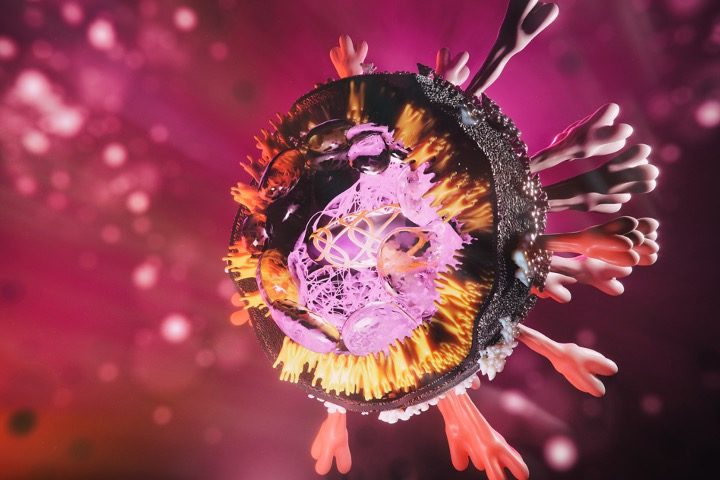
Despite the stark warning against risky biological experiments sent to the world by the Covid pandemic, research with dual-use potential on viruses continues.
Last week, a scientific team of Chinese researchers linked to the Chinese military published a study revealing that a newly discovered variant of the pangolin coronavirus results in a 100-percent fatality rate in humanized mice due to severe brain infection.
According to the paper, researchers from the Beijing Advanced Innovation Center for Soft Matter Science and Engineering and the Research Center for Clinical Medicine of the Fifth Medical Center of PLA (the People’s Liberation Army) General Hospital have come up with a variant of the SARS-CoV-2-related pangolin coronavirus, known as GX_P2V(short_3UTR), that has killed all human ACE2-transgenic mice exposed to it. The findings suggest a potential risk of spillover into humans.
The abstract reads:
SARS-CoV-2-related pangolin coronavirus GX_P2V(short_3UTR) can cause 100% mortality in human ACE2-transgenic mice, potentially attributable to late-stage brain infection. This underscores a spillover risk of GX_P2V into humans and provides a unique model for understanding the pathogenic mechanisms of SARS-CoV-2-related viruses.
The study, led by Lai Wei, Shuiqing Liu, Shanshan Lu, et al., involved cloning the GX_P2V(short_3UTR) mutant to assess its pathogenicity in 23 human ACE2 mice. Alarmingly, the mutant exhibited high viral loads in both lung and brain tissues, resulting in a 100-percent mortality rate among the infected mice within 7-8 days post-infection.
According to the study,
The mice began to exhibit a decrease in body weight starting from day 5 post-infection, reaching a 10% decrease from the initial weight by day 6. By the seventh day following infection, the mice displayed symptoms such as piloerection, hunched posture, and sluggish movements, and their eyes turned white.
“Significant” amounts of viral RNA were detected in the brain, lung, turbinate, eye, and trachea, according to the scientists.
However, the viral load in the lungs, which peaked on day 3 post-infection, decreased by day 6, while the viral load in the brain reached its highest and deadliest level by day 6, which “suggests that severe brain infection during the later stages of infection may be the key cause of death in these mice.”
According to the clinical profile of the infected mice,
On day 3 post-infection, shrunken neurons [essential brain cells] were visible in the cerebral cortex of the mice. By day 6, in addition to the shrunken neurons, there was focal lymphocytic infiltration around the blood vessels, although no conspicuous inflammatory reaction was observed.
Lai’s team pointed out that the latest revelations contradict previous findings by Shi Zhengli (aka Batwoman) et al., who tested the virulence of the “original” GX_P2V in different humanized mouse models. They elaborate:
Due to the propensity of coronaviruses to undergo adaptive mutation during passage culture, we cloned and analyzed mutations in GX_P2V(short_3UTR), focusing specifically on the pathogenicity of the cloned strains.
These new cloned strains evidently had “undergone a virulence enhancing mutation,” or an increase in their ability to cause disease and the severity of the resulting illness.
“In summary, our study provides a unique perspective on the pathogenicity of GX_P2V and offers a distinct alternative model for understanding the pathogenic mechanisms of SARS-CoV-2-related coronaviruses,” concluded the researchers.
Considering the likely laboratory origin of SARS-CoV-2, the lab-induced enhanced pathogenicity of its strains resulting in the guaranteed death of humanized mice is a concerning development.
In an exclusive statement for The New American, Dr. Robert Malone, a scientist with extensive expertise in biology and biotechnology, said:
This paper demonstrates that gain-of-function research on SARS-related viruses continues, and both reinforces our understanding of the risks of such research as well as underscoring the need for robust and verifiable restrictions on this type of research. The world community has placed effective restrictions coupled to inspections and monitoring on nuclear weapons research and development. It is long past time for similar restrictions, monitoring and inspections to stop this type of dual-function research.
In the meantime, the U.S. National Institutes of Health (NIH) continues to contract with the infamous EcoHealth Alliance, a research nonprofit that funneled NIH funds and technology to the Wuhan Institute of Virology (WIV), allegedly responsible for creating SARS-CoV-2, the virus that causes Covid-19 disease. Currently, EcoHealth is hunting for and facilitating experiments with deadly pathogens such as Ebola-like viruses and noroviruses causing Crimean-Congo Hemorrhaging fever, among others.




